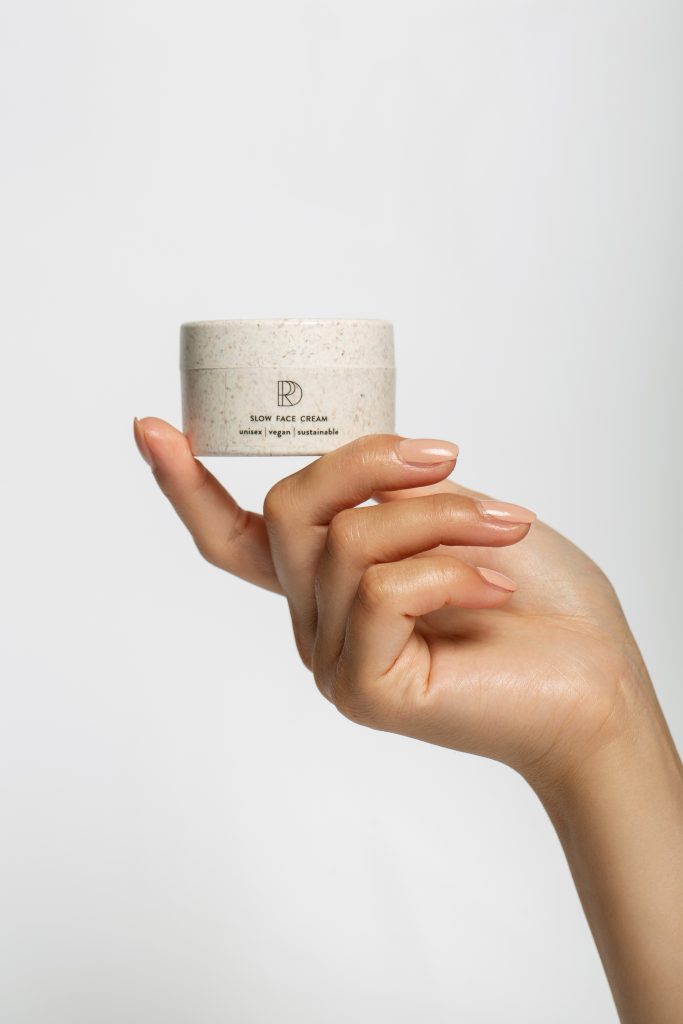
When founder Rebecca Dufour Partanen moved back to Sweden after many years in first Paris and Tokyo, and then New York — in which she pivoted to a fashion and beauty start-up — she wanted to take a hard look at the entire life cycle and value chain of how skincare is made.
— I felt the urge to create a sustainable skincare brand, she tells, and look at sustainability as not only the environmental aspect but also the human side of consuming skincare. You could say we have sustainability in the following dimensions: The production of our first product, the Slow Face Cream (made in Sweden in a factory that is very eco-conscious with natural ingredients and preservatives), the packaging (which is innovative and biodegradable and has a lower energy footprint in its production), and the marketing (diversity embedded in all our creative work, promoting realistic beauty standards and staying away from false or inflated promises).

— When it comes to marketing, I don’t want to create more insecurities, but advocate positive skincare and beauty routines. And something that really surprised me when developing the cream was that many chemists we talked to expected the cream to have a 24-36 months shelf life, and some of the first iterations of the cream didn’t pass the pressure tests that are designed with that type of durability in mind. I want to use skincare that is fresh and think this is a legacy definition that the industry lives with but is fundamentally flawed. Luckily we were able to meet the standards with natural preservatives.

In terms of sustainability, what would you say is the major issue in the beauty industry?
— I think skincare is going through a revolution that has been underway for a bit longer in food as well as fashion. The components are the same — we see a growth in conscious consumption where transparency, quality, and locality are the key components. The beauty industry has a plastic problem — too many brands use unsustainable packaging. Even if a plastic is recyclable it doesn’t mean it is recycled into a good enough product that can be used again.
— And, it’s an oversaturated market with too many products. People buy too many, don’t finish it before the expiring date, and then throws it away. Also, where’s the transparency? Where do the ingredients in our products come from? Dufour Partanen asks, adding,
— We need to start consuming locally with products that are made here. Why buy products made in South Korea when we have great products here in Sweden or even in Europe? In order to live more sustainably, we have to change our habits, one step at a time.
For the packaging, RDP Skincare has teamed up with Finnish startup Sulapac.
— Biodegradable and made from wood fiber and plant-based binders, it has revolutionised packaging in the beauty industry. All the tiny chips that you see are pieces of natural wood, which gives the jar its unique appearance and special feel. The wood comes from industrial side streams, that otherwise would’ve been wasted or burnt for energy. The wood is harvested from sustainably managed Nordic forests and the binders are always biodegradable and sustainably sourced. It has a minimal environmental impact, smaller than plastic and glass at production, and is the most sustainable alternative to plastic, Dufour Partanen explains.
She also explains how to compost the jars.
— Sulapac materials are organically recyclable. To recycle the jars, industrial composting is the preferred method taking place in an industrial composting plant, where the jar is recycled in a way that mimics nature. The materials biodegrade faster than many biodegradable plastics. Better yet, the material leaves no permanent microplastics or any harmful chemicals behind. If our material accidentally ends up in a natural environment, it biodegrades in a similar timeframe as a piece of natural wood in the forest.
— The benefits of industrial composting are many. For example, no chemicals are needed in the process. Organic recycling also contributes to greenhouse gas savings, for example, via the replacement of mineral fertilizers and carbon sequestration in soil.
— Independent accredited third-party laboratory tests have shown that microbes that can digest Sulapac materials exist in nature and in landfills. As all other biopolymers, such as collagen and native cellulose, it disintegrates first into tiny particles. However, after disintegration, the particles biodegrade fully into CO2 (CH4 if no oxygen is present), water and biomass, meaning that no permanent microplastic or hazardous chemicals are left behind during the use phase or end-of-life. Thus, Sulapac materials do not contribute to the long-term accumulation of microplastic in nature.
What else do you have coming?
— For 2022 we are looking at adding products but it won’t be in a rushed manner. This year we have been added to a showroom in Copenhagen and a few select online marketplaces focused on sustainable skincare. We have scrapped product developments that didn’t meet the bar on sustainability or have something distinctly different, but are hoping to come back and reveal more early next year, Dufour Partanen concludes.



